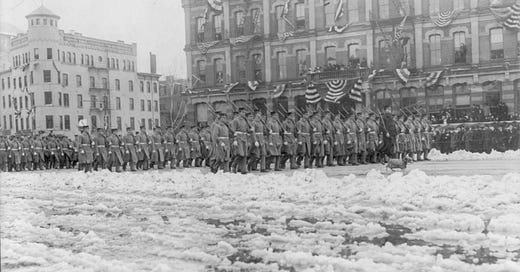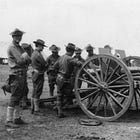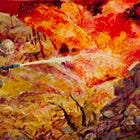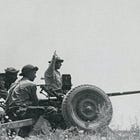The estate of the late John Sayen has graciously given the Tactical Notebook permission to serialize his study of the organizational evolution of American infantry battalions.
At this writing the Cold War has been over for more than ten years. However, the true shape of what, for want of a better term, we must call the “post-Cold War” era and how it will shape the armed forces of the world has yet to become apparent. Thus the world’s militaries, including the US Army and Marine Corps, find themselves in a period of testing and experimentation. What their combat forces will look like after is all over one can only guess. Although history is far from a panacea, the past is the only thing we really have to guide us. Unfortunately, neither the US Army nor the Marine Corps has found any good way to remember and profit from past experience. Both services have extensive libraries and archives. Both write up elaborate “lessons learned” and “after action” reports after every major training exercise or actual operation, yet the fruit of all this labor never seems to reach the troops.
Therefore, this writer hopes that this treatise on the organizational history of the US Army and Marine Corps infantry over the past 100 or so years can make some small contribution towards bringing the past to light. This writer believes that this past century is particularly important because prior to 1898, the United States had never fought a land war anywhere outside of Canada, Mexico, or its own territory. However, its war with Spain turned the United States into a colonial power with worldwide interests. Since then the United States has fought nearly all its foreign wars and gained most of its overseas military experience.
In selecting the infantry as his focus of study this writer acknowledges that it is very difficult to know just what combat arms and services will become the most important in the wars of the future. However, that the infantry will retain its former prominence seems like a safe bet. It is the simplest and least expensive of the combat arms to equip and it has formed the backbone of most armies throughout recorded history. It is still the primary agency for the capture and control real estate. However, discussions of the infantry often degenerate into a history of battles, campaigns, or specific personalities. Such matters have been exhaustively dealt with elsewhere. Instead, this history will focus on the infantry’s organization and structure, or its evolution as a weapon system. It will cover the internal functioning of the battalions and regiments in some detail, especially often-neglected issues like staff functioning and logistics. Since the focus of this work is on organization it must also consider doctrine because doctrine and organization are closely entwined. Within this context, the work concentrates on the infantry battalion (or battalion-sized regiment) because that has been the infantry’s basic fighting unit over at least the past two centuries. However, in the US Army and Marine Corps the regiment was the basic infantry element for logistics and administration until about 1960. Therefore this work will also describe regiments up until that time.
For primary source material this writer has relied heavily on the original tables of organization themselves. These are stored in a number of localities, particularly at the Army Library at Carlisle Pennsylvania, at the US National Archives (especially Record Group 127, which holds the Commandant of the Marine Corps’ papers through 1941), and at the Marine Corps Historical Center at the Washington DC Navy Yard. Other valuable material has come from the US Army’s Center of Military History, now located at Fort McNair in Washington DC. The staff members that this writer dealt with at all of these places have been extremely knowledgeable and helpful.
However, this writer’s claim to describe every American infantry regimental or battalion structure from 1898 to the present must be qualified by certain exceptions. Armored or mechanized infantry units are omitted because their story properly belongs to that of the tanks they were specifically created to support. Also missing are the specialized airfield defense battalions and squadrons fielded by the US Army and Air Force during and after World War II and for the war in Vietnam. These units were specialized organizations far more concerned with the physical security of fixed installations than with combat. Their functions were closer to those of military police than of infantry. Finally, the dismounted cavalry regiments that fought as infantry during World War II (most notably those in the 1st Cavalry Division) are also not included. They did not alter their organizational structure beyond what was necessary to dispense with their horses and to adapt themselves to the requirements of dismounted combat. Thus they never really stopped being cavalry until the end of the war when all of them either disbanded or became standard infantry.
In addition to being a narrative account this work is also intended to serve as a ready reference. Therefore it includes a lot of very detailed information, both in the text and on the numerous wire diagrams of the infantry organizations that appear in the text. In these diagrams strength breakdowns for each element can appear in two or three figures. The first figure always refers to officers and the last to enlisted personnel. If there are three figures the middle one refers to warrant officers. The diagrams are also annotated with lists of all or most weapons and certain other equipment items assigned to each sub-element described. The equipment shown is intended to give the reader an idea of the unit’s relative mobility or any special or unusual capabilities it might have. Up through the Korean War period, the ranks and duties of personnel in given sub-units are also listed. However, infantry organization after 1953 became sufficiently complex that to continue to list personnel would make the diagrams impossibly complex. Instead, the key information will appear in the text and footnotes.
The story of the American infantry battalion’s evolution to its present state has not been told before and this writer’s first priority will be to tell it. Although this writer has not always been shy about expressing his opinions in the text, he has nevertheless left it largely up to the reader to decide what lessons, if any may be drawn from this experience. Many lessons should be obvious. Others may be less obvious but that in itself should not diminish their importance.
Quantico, Virginia
1 March 2000
Editor’s Note: The format of the many appendices to this work fit poorly with Substack. For that reason, I have placed them on a PDF file that can be found at Military Learning Library, a website that I maintain.
For links to the parts of Battalion that have already been published, please see the following guides:
To share, subscribe, or support:









